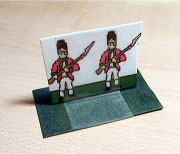There are many ways to base paper soldiers. This is a very simple method that I've used successfully with my students.
Materials
Paper: Heavy card stock or cover stock paper work nicely, but regular paper will also work
Glue: A glue stick is easy for the kids to use, and not messy
Transparent Tape: Tape should be narrower than the paper soldiers
Poster Board: This is for basing the paper soldiers. Choose a color to match your battlefield
Scissors
Dull Knife
 1. Cut, Copy, and Paste
1. Cut, Copy, and Paste
Download and save the paper soldiers you want to make on your computer. Use your favorite software to cut, copy, and paste the paper soldiers onto a page to get the mix of figures you want. I prefer to do this in PowerPoint, but that's because I'm accustomed to that program. Try to line up the dividing line between front and back of soldiers so you have a whole line of figures that can be cut out together. 2. Print
Print out your figures on paper, use heavy paper if you have it. If you don't have a good color printer you can use the black and white soldiers and color them by hand, or print opposing armies on different colored paper. You can also reproduce pages on a photocopier to preserve your precious ink cartridge.
 3. Cut, Score and Glue
3. Cut, Score and Glue
Cut out the figures, leaving plenty of white space around their edges. Try to cut out a whole row of figures if you can to speed things up. Use a dull knife to score the dividing line between the front and back of the figures. You want to score the line without cutting through it. This will make it easier to fold them in half. Try to make the line straight so the two sides will match. Fold the figures in half along the scored line so the front and back of the figures match. Use the glue stick to apply glue to both halves and firmly press them together. Use a book or similar item to smooth out the crease. Put the glued figures under a heavy book for a few minutes to allow the glue to dry flat.
 4. Cut bases
4. Cut bases
Cut the poster board into rectangular bases for your figures. The exact size isn't important, but they should be wider than the figure, and large enough that they won't be easily tipped over.
5. Cut them Apart
After the glue has dried cut the individual figures apart. Don't cut too closely to the outline of the figure, and try to leave the top of the figure flat (this will make it easier to do the next step).
 6. Basing
6. Basing
This part is a lot easier to do than it is to explain. Once you get the hang of it you'll see that it's quick and easy. Lay a figure face down flat on the base. The bottom of the figure should be at the center of the base. Get a long piece of tape and put it across the base and figure, taping the figure down. Most of the extra tape should be above the figure's head (see picture). Next, turn the figure over so it is again flat on the figure but face up. Fold the tape over the top of the figure and tape the figure down to the base on the front side. Fold the ends of the tape under the base - cut the ends if they are too long. Now the tape should run along the base, up and down the figure, and along the other side of the base. Turn the figure upright, and make sure the tape is pressed down firmly on the paper figure, or it will look a bit opaque.
 Making Your Own Figures
Making Your Own Figures
It's not that hard! I have no artistic talent, and I was able to make a bunch of reasonably good looking paper soldiers from scratch, so don't be afraid to try. The easiest way to do it would be to modify my paper soldiers. Here are some Master files you can use: poses, heads, weapons. Use your favorite software to cut, paste, and alter the figures to suit your needs. My technique is to make the front view first. Then I copy and flip the image to make the back view. Simply erase all the interior lines, leaving a silhouette, and draw the back view. This guarantees the to sides will match. Side views are even easier since you can get away with using the same image for both sides. Check out these websites for more informations on paper soldiers:
PaperWorlds.com Great resource for paper accessories for tabletop miniatures gaming, wargaming, roleplaying and more.
Cardboard Warriors website by Patrick Crusiau featuring a great how to article, and a bunch of excellent historical soldiers
Brabatini discussion group on Yahoo! Groups, about cardboard wargaming, sharing paper soldiers
Back to Table of Contents -- Junior General Report # 4
Back to Junior General Report List of Issues
Back to MagWeb.com Magazine List
© Copyright 2004 by Matt Fritz.
This article appears in MagWeb.com (Magazine Web) on the Internet World Wide Web. Other articles covering military history and related topics are available at http://www.magweb.com